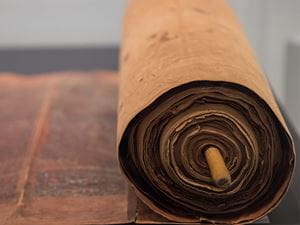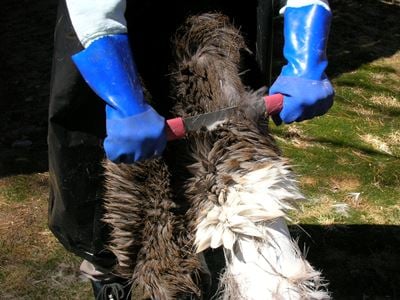
Religion Behind the Scenes spotlights the crucial but less visible tasks that keep religious communities running, and the people who make it all happen.
***
The most sacred object in Jewish life is the Torah scroll, which is a handwritten Hebrew copy of the five books of Moses. A kosher Torah, meaning one that is fit to be used in synagogue, must be without any written mistakes. If even one of the 304,805 letters in a Torah scroll is found to be inaccurately rendered, or the ink of one of the letters has become chipped, the entire scroll is retired until it is fixed by a certified scribe. Nobody is allowed to physically touch the letters of the scroll, for fear of scraping or damaging one of the letters. The scroll is housed in an ark at the front of the synagogue, and when it is brought out to be read during prayers, everyone has to stand in its honor. Usually, the Torah scroll is carried throughout the synagogue so that each congregant can kiss it before it is ritually unwrapped and the weekly reading can be chanted. The Torah scroll is never allowed to touch the floor.
How does this holy object get made? Read our ‘Behind the Scenes’ story with Rabbi Linda Motzkin.
***
Rabbi Linda Motzkin, and her husband, Rabbi Jonathan Rubenstein, have served as the co-rabbis of Temple Sinai in Saratoga Springs, New York since 1986. An accomplished artisan, scribe, and scholar of Biblical Hebrew, she has been making klaf, or ritual parchment, since 2003, when a congregant called up and asked if she would like two freshly killed deer skins. She said yes.
Walk us through the process of creating a Torah scroll, from the very beginning. Where do you begin?
Well, the first thing is that the scroll is made of parchment. One of the misconceptions a lot of people have is that parchment is paper, because there exists such a thing called parchment paper, but real and true parchment is animal skin.
So how does one make parchment? One has to have a supply of animal skins, which is a little tough, I suppose, if you live in Brooklyn, New York. But if you live up in Saratoga Springs at the foothills of the Adirondacks, everybody knows hunters. Your next door neighbor is a hunter, your coworker’s nephew is a hunter. When I started making parchment, all I had to do was put word out in the community that I wanted deer skins, and I started getting deer skins.
There are several steps involved in transforming an animal skin into parchment.
When I get a hide, it's fresh off the deer, so it has blood and meat on the inside and it has fur on the outside. And the very first step is fleshing, which is scraping to remove the blood and meat from the inside. The next step is soaking. The hide has to soak in a bin with a solution to alter the pH balance of the hides so that the hair is loosened. And then the next step is de-hairing, or scraping the outside now that the hair has been loosened so that you can get it off.
And then the next step is another soak, but in fresh flowing water, to restore the natural pH balance that was altered by the solution to loosen the hair. I happen to be fortunate that there's a stream that runs downhill in the woods behind my backyard where I can throw the hide in for 24 hours for it to soak in fresh running water. Then it gets stretched on a hide stretching frame.
The frame is not something you can go to Target or some local store to buy. I have three hide stretching frames in my garage that I constructed. There is the whole story of how I learned about making hide stretching frames, but that’s for another time. Once the hide is stretched on the frame and dried under tension, it goes through several subsequent sandings.
I have three different sanders. A heavy grit sander, a medium grit, and a fine sander. The hide starts at the thickness of leather and it has to get down to the thinness of parchment. You start with a heavy grit sander, and then the subsequent steps are smoothing the surface. The fine sanding at the end is to get a really smooth, fine surface for writing. You can’t have any nicks and scrapes that will catch your quill and ruin your writing. The next step after that is cutting it, which involves taking it off the frame, measuring it into the rectangle that will be the panel of the Torah, and then scoring the guidelines for the columns in each row of writing. Next step after that is writing. But then we're no longer in the parchment making stages. The next stages have to do with making a Torah, but not with parchment making.
So you need a lot of tools!
Well, there is a tool called a flesher that is used for fleshing, which is scraping the meat and blood and tissue from the inside of the hide. The flesher can be used for dehairing, though your hand in a heavy glove is also pretty effective at the dehairing. And then there is what's called the fleshing beam, which in my case it's a PVC pipe that I prop up against the tree in my backyard and throw the hide over it and then use a hose to sort of hose down the hair while I'm also using my gloved hand to pull the hair out. The hose helps me see tiny little hairs because they get caught on the trickle of water and create ripples that otherwise, with my naked eye, I might miss.
You really want to get all the hairs out because otherwise, having tiny hairs in what will be the backside of your parchment might have textures that could, once it's in a Torah scroll all rolled up, rub against the ink of the panels it's rolled up against. I don't know if that makes sense, but tiny hairs rolled against the ink would begin to damage the words.
So I have my flesher, I have my fleshing beam, which is a PVC pipe, and I have my gloves. I have goggles because you don't want stuff getting into your eyes in the early stages of the soaking solution. The soaking solution that I use is basically alkaline, which alters the pH balance of the hide. In Talmudic times what you used was animal dung, which is acidic. You can alter the pH balance by either making the hide more alkaline or more acidic, it doesn't matter which.
A lot of people don't realize that parchment is not tanned hide. It is rawhide. It is dried and stretched and sanded under tension, but it is not tanned. It doesn’t undergo the chemical change that suede or leather has. That's why water is so dangerous for a Torah scroll.
Because if rawhide gets wet, it reverts to being all squishy and wring-out-able, like a wet towel, and it no longer has its stiffness at all. And once it dries, it will totally wrinkle up. If rawhide doesn't dry under tension, it just shrivels up like that rawhide chew that you might give your dog to chew on.


What are the differences between making klaf, or animal parchment that can be used for a Torah scroll, and making regular animal parchment?
Number one, it has to be the skin of a kosher animal. People ask me that all the time – they say, "But deer aren’t kosher!" But actually, deer are kosher. The reason that most people think deer aren't kosher is because most venison, most deer meat, isn't kosher. But the reason most deer meat isn't kosher is not because the animal isn’t kosher but because the method of slaughter isn't kosher. For meat to be kosher it has to come from a kosher animal and also be killed by the kosher method of slaughter, and hunting an animal is not a kosher method of slaughter, which is why most venison is not kosher.
For parchment making, the animal has to be kosher, but it doesn't matter how the animal was killed, which is why I can use these deer skins from animals that were hunted by hunters. Even though that meat wouldn’t be kosher, the skins can make a kosher parchment.
So to make kosher parchment, the hide has to come from a kosher animal, and a statement of sanctification has to be made at the outset of the processing, which is defined by halacha, Jewish law, as the moment when you put the hide into the soaking solution to soak, to loosen the hair for the next step.
And if you forget to make that statement at that moment, you cannot retroactively make that statement. You could still go on to make a perfectly nice piece of parchment, but it will not be kosher parchment, and you cannot use it for kitvei kodesh, sacred writings. I learned that the hard way when I first started, and that is a hide which I now use as a visual when I give classes on the process.
What is the statement of sanctification?
The basic statement is that I'm doing this for the sake of the holiness of the sefer Torah, the Torah scroll. Translated from the Hebrew, it is "I am processing. these hides for the sake of the holiness of a Torah scroll, and for this purpose, I am placing them into the lime." You make statements of sanctification like this for all the different stages in making a Torah. Like, ‘this hide I am scoring for the sake of the holiness of the sefer Torah.’ Or when you sew the panels of parchment together, you say ‘I am sewing this for the sake of the holiness of sefer Torah,’ etc.
But when you're processing parchment, there's an additional phrase: ‘And I also declare as a condition that if I want to change the level of sanctity from sefer Torah to one of these other lower levels of sanctity, tefillin, tefilling casings, mezuzah, the authority to do so will remain with me. (Editor: These are other Jewish ritual objects which must be made from animal skin).
There are different levels of sanctity for parchment, and one can only use for a Torah scroll parchment which has been sanctified for Torah scrolls. And when one is making parchment, you have to have an intention of what you want to use it for. But if you want to leave open the possibility that it could be used for something else if it turns out to be unsuitable for your primary purpose, then you need to articulate that intention and set that as a condition when you're processing or else you cannot change its level of sanctity afterwards.
I would say these days, anybody who is making parchment is making parchment with a conditional statement. Because parchment making is so much work, and when you start making parchment, even if you have the intention that you want it to be for a Torah scroll, not every piece of parchment that you start processing is going to wind up being suitable for a Torah scroll.
For example, when you're putting the hide into the solution for dehairing, which is when you say the blessing of sanctification, it hasn't actually been dehaired yet. You haven't been able to see where there is scar tissue on that hide, where there's unseemly blemishes. You may think you've seen where all the holes are, but there may be tiny holes that you've missed, and once you get the hair off and you look at it, you realize, I can't actually cut out of this hide a big enough rectangle to be used for a Torah scroll.
And so, because of all the work involved, you want to be sure when you start, even if your intention is for Torah, that you still leave open the possibility that okay, I won't have a big enough piece for a Torah panel. But I'll still have plenty of smaller pieces that could be klaf, kosher parchment, for mezuzah, or smaller pieces that could be used for tefillin. Otherwise, it would be wasting a lot.
I think people tend to think of holiness as something that's very pristine and clean. It’s interesting to think about how a hide can go from a sack of skin on your doorstep to the most sacred object in a synagogue.
One of the things that I've often thought about is that of all the different stages in the making of a Torah, the stage where you're at the outset of parchment making is the one that is the most…oh, for lack of a better expression, I think I'll say it has the highest yuck factor. It's really yucky. The hides smell. It's a dead animal, and it's gross. And I also find it very interesting that it's right at this moment, when your senses are all being assailed by the stuff that's not very pleasant, that's when halacha, Jewish law, says: Oh, we make this statement, that this is for the sake of the holiness of the most sacred ritual object of our tradition. Just when your brain might be going to this place of ‘oh, God!’ our Jewish tradition says no. This, too, is holy.
The sacred is found even in blood and guts and bad smells. It's not just in the beautiful cream colored parchment with lovely black Hebrew calligraphy that's at the end stage.
How much of this process has changed over the years?
I had the good fortune of being able to visit a parchment making factory outside of Jerusalem toward the end of my learning curve on making parchment, because I really wanted to be sure that what I was doing was all in accordance with halacha, Jewish law, before I started using any of this parchment for writing a Torah. I just wanted to make sure I wasn't missing any important halachic steps.
When I visited this professional 21st century parchment making factory, one of the things that was very interesting for me to see was how little of the process is mechanized. To this day, you have an individual frame for each skin. Each individual hide has to be scraped and sanded. There are time saving devices, and there is equipment that I don't have that professional studios have; for example, they had this very cool cutting and scoring machine where you could sort of program how far apart you wanted each of the lines to be in, and there would be a bar that would drop for each line, so you didn't have to manually put down your ruler and score each line like I do. But even with that, each individual piece of parchment still had to be done individually and the scribe had to score each piece individually. There's no mechanized way of mass producing parchment making. So I don’t know for sure, but it hasn’t changed all that much.
Do you ever have people in your congregation struggle with the fact that a Torah scroll has to be made from a dead animal? Especially for congregants who are vegetarian or vegan, I imagine the process might seem off putting to some.
I actually get asked that question a lot, because I've been a vegetarian since before I was in rabbinical school. And my husband is too. In fact, in rabbinical school, he divested himself of all of his leather possessions. He no longer wore leather shoes. He didn't wear leather belts. And today, I am closer to vegan than vegetarian, and so people ask me all the time: "Rabbi Linda, how can you do this? You’re a vegetarian!" And it is something I think about. There's a lot of things in our Jewish spiritual practice that depend on animals. Tefillin, sefer Torahs, mezuzah; and I think about it also in relation to that statement of sanctification that we make at the outset.
For me personally, I don't eat meat. I wouldn't kill an animal to eat it. And I also don't kill the animals I'm making parchment from. But every single animal that I'm making parchment from was killed by a hunter who killed that animal for the sake of providing food for his or her family.
So in some ways it's a more ethical way of obtaining meat. And it’s actually one of the reasons why years ago I became vegetarian. It wasn't because I didn't like meat. I loved meat. It was because I learned about where it came from and didn't feel ethically that I could eat it anymore. The standard meat processing for kosher meat has the same ethical problems as overall agrobusiness. And in a weird way, making this parchment from deer skins feels like it's kind of, to use the language of Jewish mystics, lifting up of sparks, or the sparks of holiness that are embedded in all matter--because these skins come from animals that were killed by hunters who are providing what seems to be a fairly ethical way to feed their families. And the skins are the one part of the animal they can't use because you can't eat the skins. And every one of these hunters who is giving me a skin to become part of this project had the choice of just throwing the skin in the garbage instead of going to the extra work of bagging it into a heavy black garbage bag, calling me on the phone, making arrangements to meet me somewhere, and give me the hide so that I could do this processing.
They didn't have to do that. All of them did that because of some sense of respect for the animal or idea that no part of it should go to waste. Or they thought "why should I throw out this hide when there's someone who can use it?"’ And maybe even an interest in being part of a sacred process, although the overwhelming majority of the hunters that I get hides from are not Jewish. A few are. Most of them aren't. Some of them have never even heard of a Torah scroll. Yet, there is still this kind of attitude of sort of respect for where meat comes from, and respect toward the animal. And I feel like that's a part of what I and the volunteers from my congregation I am working with are thinking of, part of our mindfulness moment when we make the statement of sanctification. I'm not sure quite what to make of this. I sort of answered, I guess, for how I deal with it individually for me.
We're taking this skin that came from a living, breathing creature, and which could have become garbage, and instead it is going to become something tremendously holy through our efforts.
Interview conducted, edited, and condensed by Shira Telushkin
--
Shira Telushkin is the managing editor of special projects at Patheos, where she combines her love of stories with her love of all things religion. A graduate of the Harvard Divinity School, she writes, edits, and produces media projects related to faith and beauty in all their forms.
7/13/2022 10:01:44 PM









